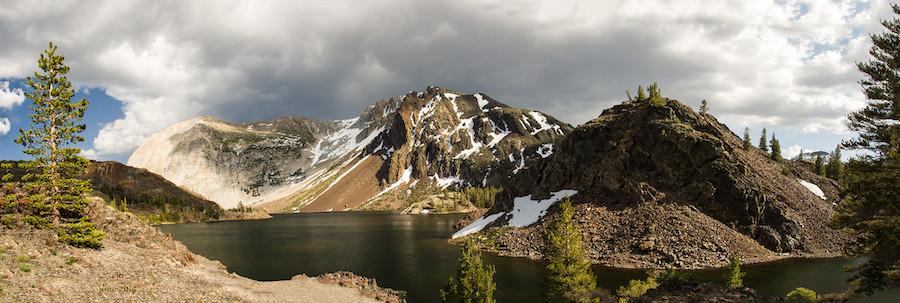
CLIMATE CHANGE AND SIERRA NEVADA BIRDS

Climate change is a vast and complicated issue for land managers and biologists. Nearly all of our research and conservation work in the Sierra Nevada is informed by climate change questions in one way or another. Examples include helping design and assess meadow restoration that may enhance resilience to climate change as winter snowpack decreases; considering how climate change will affect wildfire behavior, and how fire will affect birds; and using demographic monitoring to assess how weather variation affects bird populations.
In a rapidly changing climate, effective bird conservation requires credible projections of species’ vulnerability to future conditions. In an analysis funded by the California Landscape Conservation Cooperative and published in 2014, IBP scientists and colleagues predicted vulnerability of 168 species that breed in the Sierra Nevada. The analysis assessed exposure and sensitivity to climate change, incorporating information about each species’ distribution and ecological relationships using two climate change models. Only White-tailed Ptarmigan was ranked Extremely Vulnerable. Sixteen species scored as Moderately Vulnerable: Common Merganser, Osprey, Bald Eagle, Northern Goshawk, Peregrine Falcon, Prairie Falcon, Spotted Sandpiper, Great Gray Owl, Black Swift, Clark’s Nutcracker, American Dipper, Swainson’s Thrush, American Pipit, Gray-crowned Rosy-Finch, Pine Grosbeak, and Evening Grosbeak.
IBP has been working with the U.S. Forest Service to study the potential impacts of climate change on Sierra Nevada birds. In this short video, IBP Executive Director Rodney Siegel describes IBP’s work at Yosemite’s MAPS stations, some of the longest-running MAPS Stations in the country.
Species associated with alpine or subalpine habitats and aquatic ecosystems received significantly more vulnerable rankings than birds associated with other habitats. In contrast, species primarily associated with foothill, sagebrush, and chaparral habitats ranked as less vulnerable than other birds. Results suggested that some of these species may respond to climate change in the region with population increases or range expansions.
A 2019 IBP study used 24 years of bird banding data from MAPS stations [LINK] in Yosemite National Park to see how the timing of breeding and breeding productivity of 25 bird species changed in response to a changing climate. Birds seemed to track the changing climate fairly well, breeding earlier in years with warmer springs and less snowpack. Species whose ranges are known to have shifted upslope during the past century generally had higher productivity at higher compared to lower elevations. Many species also produced more young as spring temperatures increased and snowpack melted sooner; possibly because of earlier and greater insect abundance. This is mostly good news, but there is almost certainly a limit where conditions become too warm and too dry and begin to have negative impacts on breeding.
Results of these two studies, as well as IBP’s ongoing work on birds, climate, fire, and forest management, will help Sierra Nevada land managers to prioritize conservation and management actions that benefit the species that are most likely to need them.
For more information on IBP’s work with climate change and Sierra Nevada birds, please contact Rodney Siegel.
Photo Credits: Top of Page, Ed Brownson; Right Column: Kelly Colgan Azar.
RECENT RESEARCH
Back in the summer of 1977, IBP founder Dr. David DeSante took a group of students to work at the Harvey Monroe Hall Research Natural Area, which covers more than 1,500 hectares of alpine habitat, subalpine forest, and meadows on the eastern border of Yosemite National Park. DeSante had long wanted to initiate a long-term bird study and had recently gained access to the site.

“At first, I didn't know exactly what we were going to do there,” says DeSante. But climate change was on his mind. “There was enough information about it even then; that it was happening and was serious.” DeSante and his students established grids across a 100-hectare subalpine site and, by the end of the summer, realized that they could map the territories of all bird species breeding on the site and determine their breeding productivity. They also recorded climate variables. DeSante would return year after year with students and volunteers; a 32-year subalpine bird and climate study was born.
In “Climate variation drives dynamics and productivity of a subalpine breeding bird community,” DeSante and co-author Jim Saracco present some of the results of this long-term study, which ran from 1978 to 2009. They found that annual weather varied widely over the course of the study. Spring and summer temperatures tended to increase and snowpack melted earlier as the study went on, while summer precipitation decreased.
During years with earlier snowmelt and warmer springs, greater bird species richness, greater numbers of breeding territories, and earlier fledging dates were recorded, but fewer fledglings were produced per breeding territory. Three species showed strong evidence of a population trend: populations of Clark’s Nutcrackers and Chipping Sparrows declined, while populations of Yellow-rumped Warblers increased.
This study provides a rare, multi-decade view of the complex effects of rapid climate change on a high-elevation bird community. It also demonstrates the value of collecting fundamental natural history data, year after year.
SELECTED PUBLICATIONS
Peer-reviewed Publications
Neate-Clegg, M.H.C., J.F. Saracco, F. Rodríguez-Vásquez, and S.E.I. Jones. 2024. Unraveling demographic patterns in tropical birds across an elevational gradient. Ornithological Applications 127:1–14. PDF
Schofield, L.N., R.B. Siegel, and H.L. Loffland. 2023. Modeling climate-driven range shifts in populations of two bird species limited by habitat independent of climate. Ecosphere 2023;14:e4408. PDF
Youngflesh, C., G.A. Montgomery, J.F. Saracco, D.A.W. Millerd, R.P. Guralnicke, A.H. Hurlbert, R.B. Siegel, R. LaFrancee, and M.W. Tingley. 2023. Demographic consequences of phenological asynchrony for North American songbirds. Proceedings of the National Academy of Sciences 28:e2221961120. PDF
Desrosiers, M.A., L.N. Schofield, B.K. Jackson, and S.S. Stock. 2022. Low flows in a regulated river system are associated with reduced breeding bird abundance and diversity in Yosemite National Park, California. River Research and Applications 2022:1-17. PDF
Pandolfino, E.R., L.A. Douglas, and C. Ray. 2022. Irruptive movements of the Black-Chinned Sparrow (Spizella atrogularis) in response to variations in precipitation: implications for climate change resiliency. Western Wildlife 9:24-37. PDF
Ray, C., R.L. Wilkerson, R.B. Siegel, M.L. Holmgren, and S.A. Haultain. 2022. Landbird population trends in parks of the Sierra Nevada Network: 2011-2019 synthesis natural resource report NPS/SIEN/NRR 2022/2402. Available at https://irma.nps.gov/DataStore/DownloadFile/673059.
Saracco, J.F., R.L. Cormier, D.L. Humple, S. Stock, R. Taylor, and R.B. Siegel. 2022. Demographic responses to climate-driven variation in habitat quality across the annual cycle of a migratory bird species. Ecology and Evolution 2022;12:e8934. PDF
Siegel, R. and R. Wilkerson. 2022. A giant loss: losing sequoias could be a blow to Sierra Nevada Birds. The Wildlife Professional 16:54-55. PDF
Youngflesh, C., J.F. Saracco, R.B. Siegel, and M.W. Tingley. 2022. Abiotic conditions shape spatial and temporal morphological variation in North American birds. Nature Ecology and Evolution. DOI 10.1038/s41559-022-01893-x.
DeSante, D.F., and J.F. Saracco. 2021. Climate variation drives dynamics and productivity of a subalpine breeding bird community. Ornithological Applications 123:1-16. For a copy of this publication, please contact Jim Saracco.
Schofield, L.N., S.A. Eyes, R.B. Siegel, and S.L. Stock. 2020. Habitat selection by spotted owls after a megafire in Yosemite National Park. Forest Ecology and Management 478:118511. PDF
Ray, C., D.R. Cluck, R.L. Wilkerson, R.B. Siegel, A.M. White, G.L. Tarbill, S.C. Sawyer, and C.A. Howell. 2019. Patterns of woodboring beetle activity following fires and bark beetle outbreaks in montane forests of California, USA. Fire Ecology 15:21. PDF
Saracco, J.F., R.B. Siegel, L. Helton, S. Stock, and D. DeSante. 2019. Phenology and productivity in a montane bird assemblage: trends and responses to elevation and climate variation. Global Change Biology 2019:25;985-086. PDF
Stillman, A.N., R.B. Siegel, R.L. Wilkerson, M. Johnson, C.A. Howell, and M.W. Tingley. 2019. Nest site selection and nest survival of Black-backed Woodpeckers after wildfire. The Condor: Ornithological Applications 121(3). PDF
Siegel, R.B., R. Taylor, J.F. Saracco, L. Helton, and S. Stock. 2016. GPS-tracking reveals non-breeding locations and apparent molt migration of a Black-headed Grosbeak. Journal of Field Ornithology 87:196-203. PDF
Tingley, M.W., V. Ruiz-Gutiérrez, R.L. Wilkerson, C.A. Howell, and R.B. Siegel. 2016. Pyrodiversity promotes avian diversity over the decade following forest fire. Proceedings of the Royal Society B 283:20161703. (For a copy of this publication, please contact Rodney Siegel.)
Siegel, R.B., P. Pyle, J.H. Thorne, A.J. Holguin, C.A. Howell, S. Stock, and M. Tingley. 2014. Vulnerability of birds to climate change in California’s Sierra Nevada. Avian Conservation and Ecology 9:7. PDF
Siegel, R.B., R.L. Wilkerson, J.F. Saracco, and Z.L. Steel. 2011. Elevation ranges of birds on the Sierra Nevada’s west slope. Western Birds 42:2-26. PDF
DeSante, D.F. 1990. The role of recruitment in the dynamics of a Sierran subalpine bird community. American Naturalist 136:429-455.
Other Publications and Reports
Steel, Z.L., M.L. Bond, R.B. Siegel, and P. Pyle. 2012. Avifauna of Sierra Nevada Network parks: assessing distribution, abundance, stressors, and conservation opportunities for 145 bird species (Appendix A, species accounts). Natural Resource Report NPS/SIEN/NRR—2012/506A. National Park Service, Fort Collins, CO. PDF
Steel, Z.L., M.L. Bond, R.B. Siegel, and P. Pyle. 2012. Avifauna of Sierra Nevada Network parks: assessing distribution, abundance, stressors, and conservation opportunities for 145 bird species. Natural Resource Report NPS/SIEN/NRR—2012/506. National Park Service, Fort Collins, CO. PDF
Nott, M.P. 2002. Climate, weather and landscape effects on landbird survival and reproductive success in Texas. Technical report to the Texas Army National Guard Command: Adjutant General's Department and U.S. Department of Defense Legacy Resources Management Program. The Institute for Bird Populations, Point Reyes Station, CA. PDF








